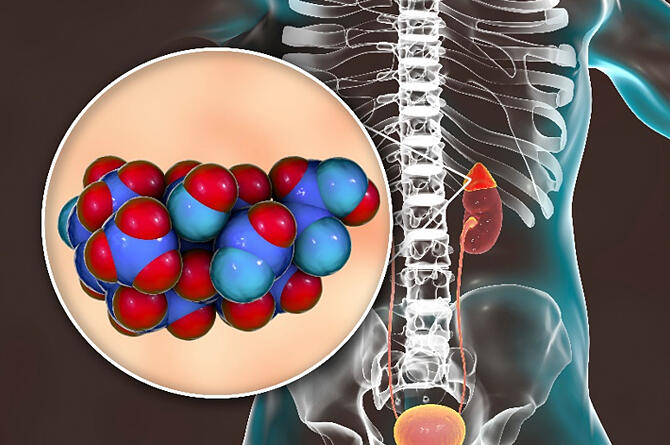Senior Professor Akihiko Ito of the School of Medicine at Kindai University, Professor Yutaka Takaoka, Vice Director of the Advanced Antibody Drug Development Center at the University of Toyama, Specially-Appointed Professor Fumitoshi Sato of the Graduate School of Medicine at Tohoku University, and Instructor Kenji Oki of the Graduate School of Medicine at Hiroshima University collaborated with Queen Mary University of London, and announced that they had identified the cause of "primary aldosteronism," a type of high blood pressure (hypertension), as a mutation in gene encoding a cell adhesion protein "CADM1." They found that mutations in this molecule impair cell-to-cell communication, which causes oversecretion of the hormone aldosterone, which in turn leads to hypertension. The results are expected to lead to new diagnoses of hypertension and the development of therapeutic agents. The findings were published in the June 8 issue of an international academic journal, Nature Genetics.

Provided by Kindai University
Primary aldosteronism is a condition of hypertension caused by excessive secretion of aldosterone from the outer layer or cortex of the adrenal glands. This condition accounts for about 10% of all hypertension cases (estimated at 43 million patients in Japan, or around 1 in 3 people), and about 20% of the treatment-resistant hypertension cases. Compared with regular hypertension, this condition is often accompanied by complications of the heart and blood vessels and requires medical attention. Benign growths, such as aldosterone-producing adenomas, occur in the adrenal cortex. These can be treated by removing the lesions, but if the growth is small or difficult to find, treatment-resistant hypertension may be a concern. Although several gene mutations have been identified as causative genes for hypersecretion of aldosterone, other unknown causes still exist.
The research group discovered that mutations in the CADM1 gene were present in aldosterone-producing adenomas. The mutation was discovered by a collaborator Dr. Maurice Brown (University of London) in an adrenal gland harvested from a patient with the disease. Mutations in the same gene were found in six other cases during an international joint research project of Dr. Brown with collaborators in Europe, the United States, and Japan. The gene is responsible for production of a protein that forms part of the membrane of cells. The produced protein penetrates through the cell membrane once. This protruding part of the protein joins with the same part of a similar protein on an adjacent cell, acting as a bridge between cells, and creating a suitable gap for cell-to-cell interactions.
All of the six identified mutations occurred at the same region where the protein penetrates through the cell membrane, causing substitutions of single amino acids (the building blocks of proteins) known as G379D or V380D.
First, expression of mutant CADM1 in cells of the adrenal cortex markedly increased aldosterone secretion. When they examined the expression of CADM1 in aldosterone-producing adenomas, they found that it was highly expressed on the cell membrane and was speculated to be involved in cell adhesion molecules. They then used a computer simulation to analyze how the molecular structure of CADM1 was changed by a single amino acid substitution in the membrane-penetrating region.
From this, they found that the transmembrane region was shortened by the mutation, which increased the penetration angle, and consequently increased the distance between cells. Normally, CADM1 is angled obliquely at an angle of 49 degrees to the cell membrane, but when the protein is mutated, this angle becomes more acute, positioning the protein closer to the vertical relative to the cell membrane (62 degrees or 90 degrees). The simulation showed that the distance between cells with the normal protein is about 20 nm, whereas for cells with the mutant protein, the distance is about 25 nm depending on the mutation.
They then focused on the connections (gap junctions) formed by protein complexes, known as connexin complexes, that are responsible for cell-to-cell communication. They examined the possibility that these junctions might become defective if the cell-to-cell distance is increased. Gap junctions are portals formed by pairs of complexes on the membranes of adjacent cells, which allow the transfer of ions and molecules between cells.
In their experiments, dyes that can move between cells only via gap junctions were added to single layers of adrenal cortex cells with normal CADM1 or with mutant CADM1, and the results were compared.
They found that the dyes spread through the gap junctions of cells with the normal CADM1 but could not spread through cells with the mutant type, implying that these gap junctions are defective. Furthermore, they confirmed that aldosterone was overproduced in cells with the mutant CADM1 by adding a gap junction inhibitor to these cultured adrenal cortex cells. This is the first demonstration that hypertension can be caused by defective gap junctions.
The incidence of genetic mutations of CADM1 is considered to be approximately 1%, with large interracial differences.
Ito stated, "Gap junction defects are not necessarily caused by genetic mutations, but are thought to occur under certain pathological conditions, such as in the presence of accelerated protein degradation. It is expected that hypertension due to excessive secretion of aldosterone in such pathological conditions could be treated with new therapeutic drugs or with diversion of existing therapeutic drugs. In the future, I would like to investigate whether such hypertension actually exists."
This article has been translated by JST with permission from The Science News Ltd. (https://sci-news.co.jp/). Unauthorized reproduction of the article and photographs is prohibited.




